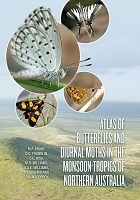Atlas of Butterflies and Diurnal Moths in the Monsoon Tropics of Northern Australia
| dc.contributor.author | Braby, Michael | |
| dc.contributor.author | Franklin, Donald | |
| dc.contributor.author | Bisa, Deborah | |
| dc.contributor.author | Williams, Matthew | |
| dc.contributor.author | Williams, Andrew | |
| dc.contributor.author | Bishop, Carly | |
| dc.contributor.author | Coppen, Rebecca | |
| dc.date.accessioned | 2019-01-07 23:55 | |
| dc.date.accessioned | 2018-12-01 23:55:55 | |
| dc.date.accessioned | 2019-01-07 14:01:46 | |
| dc.date.accessioned | 2020-04-01T11:50:31Z | |
| dc.date.available | 2020-04-01T11:50:31Z | |
| dc.date.issued | 2018 | |
| dc.identifier | 1002641 | |
| dc.identifier | OCN: 1076493279 | en_US |
| dc.identifier.uri | http://library.oapen.org/handle/20.500.12657/27367 | |
| dc.description.abstract | "Northern Australia is one of few tropical places left on Earth in which biodiversity—and the ecological processes underpinning that biodiversity—is still relatively intact. However, scientific knowledge of that biodiversity is still in its infancy and the region remains a frontier for biological discovery. The butterfly and diurnal moth assemblages of the area, and their intimate associations with vascular plants (and sometimes ants), exemplify these points. However, the opportunity to fill knowledge gaps is quickly closing: proposals for substantial development and exploitation of Australia’s north will inevitably repeat the ecological devastation that has occurred in temperate southern Australia—loss of species, loss of ecological communities, fragmentation of populations, disruption of healthy ecosystem function and so on—all of which will diminish the value of the natural heritage of the region before it is fully understood and appreciated. Written by several experts in the field, the main purpose of this atlas is to compile a comprehensive inventory of the butterflies and diurnal moths of northern Australia to form the scientific baseline against which the extent and direction of change can be assessed in the future. Such information will also assist in identifying the region’s biological assets, to inform policy and management agencies and to set priorities for biodiversity conservation." | |
| dc.language | English | |
| dc.subject.classification | thema EDItEUR::R Earth Sciences, Geography, Environment, Planning::RN The environment::RNC Applied ecology::RNCB Biodiversity | en_US |
| dc.subject.classification | thema EDItEUR::R Earth Sciences, Geography, Environment, Planning::RN The environment::RNK Conservation of the environment::RNKH Conservation of wildlife and habitats | en_US |
| dc.subject.other | Science | |
| dc.subject.other | Biodiversity | |
| dc.subject.other | Conservation | |
| dc.subject.other | Butterfly | |
| dc.subject.other | Moth | |
| dc.title | Atlas of Butterflies and Diurnal Moths in the Monsoon Tropics of Northern Australia | |
| dc.type | book | |
| oapen.identifier.doi | 10.22459/ABDM.12.2018 | |
| oapen.relation.isPublishedBy | ddc8cc3f-dd57-40ef-b8d5-06f839686b71 | |
| oapen.relation.isbn | 9781760462321 | |
| oapen.pages | 462 | |
| oapen.identifier.ocn | 1076493279 |

